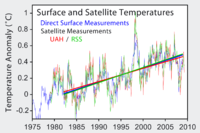
Photo from wikipedia
The western Pacific subtropical high (WPSH) and sea surface temperatures have experienced marked interdecadal changes. However, whether the relationships between the WPSH and sea surface temperature forcings (SSTFs) have also… Click to show full abstract
The western Pacific subtropical high (WPSH) and sea surface temperatures have experienced marked interdecadal changes. However, whether the relationships between the WPSH and sea surface temperature forcings (SSTFs) have also experienced an interdecadal transition remains unclear. This study analyses the interdecadal shift in the relationship between the WPSH and SSTFs. The results clearly reveal the occurrence of two interdecadal transitions in the relationship between the leading empirical orthogonal function modes, which represent the intensity of the WPSH and the SSTFs: one in approximately 1976–1977 and the other in 1993–1994. The positive first principal component is closely related to the equatorial eastern and central Pacific (EECP) warming and the western North Pacific (WNP) cooling in spring and summer of the three periods. The discharging process of the ‘Indian Ocean Capacitor Effect’ in summer was suppressed by the downdraft during the periods 1978–1992 and 1995–2013, which caused the tropical Indian Ocean (TIO) warming to have little influence on the WNP anomalous anticyclone (WNPAC) in summer. The positive second principal component corresponds to significantly positive sea surface temperature anomalies in the TIO, the maritime continent, the WNP, the North Pacific cooling in spring and summer, and the EECP cooling in the summer, while it is significantly related to only the positive-phase North Atlantic tripole (NAT) in the spring in the years 1954–1975. The enhancement of the WNPAC by the NAT was partly offset by the tropical North Atlantic warming with a positive tropospheric temperature anomaly. Additionally, an anticyclone over the North Pacific Ocean accelerated the phase shift of El Nino/Southern Oscillation from El Nino to La Nina in the spring in the years 1995–2013.
Journal Title: International Journal of Climatology
Year Published: 2017
Link to full text (if available)
Share on Social Media: Sign Up to like & get
recommendations!